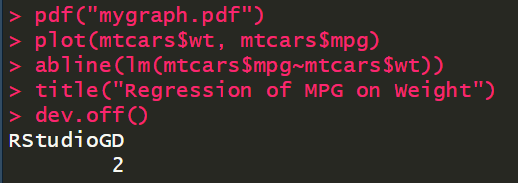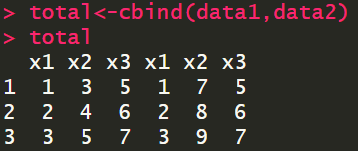图形初阶
创建和保存图形
plot(mtcars$wt, mtcars$mpg) abline(lm(mtcars$mpg~mtcars$wt)) title("Regression of MPG on Weight")
保存为pdf
pdf("mygraph.pdf") plot(mtcars$wt, mtcars$mpg) abline(lm(mtcars$mpg~mtcars$wt)) title("Regression of MPG on Weight") dev.off()
除了pdf()外,还可以使用函数png(), jpeg(), bmp(), tiff()等将图形保存为其他格式
创建新图形窗口
dev.new()
图形参数的修改
·一个例子
dose <- c(20,30,40,45,60) drugA <- c(16,20,27,40,60) drugB <- c(15,18,25,31,40) plot(dose,drugA,type="b")
type="b" 表示画点图
修改图形参数的方法
①通过par()函数修改
②在绘图函数中直接设置
使用实心三角形和虚线绘图
opar <-par(no.readonly = TRUE) par(lty=2,pch=17) plot(dose, drugA, type="b") par(opar)
plot(dose, drugA, type="b", lty=2, pch=17)
符号和线条参数
颜色参数
n <-10 mycolors <-rainbow(n) pie(rep(1,n), labels=mycolors, col=mycolors)
指定文本属性参数
图形尺寸与边界尺寸参数
opar <-par(no.readonly = TRUE) par(pin =c(2,3)) par(lwd=2, cex=1.5) par(cex.axis=.75, font.axis=3) plot(dose,drugA,type="b",pch=19,lty=2,col="red")
设置坐标轴和文本标注
plot(dose, drugA, type="b", pch=19, col="blue", cex.axis=1.5, col.axis="darkgreen",font.axis=2, main="这是主标题:plot初探", font.main=2, cex.main=2, col.main="green", sub="这是副标题:图1", font.sub=3, cex.sub=1.5, col.sub="red", xlab="dose", ylab="drugA", cex.lab=1.5,font.lab=1,col.lab="grey20", xlim=c(0,60),ylim=c(0,70))
添加次刻度线
添加参考线
plot(dose, drugA, type="b") abline(h=c(40), v=c(40), lty=2, col="blue")
添加图例
opar <-par(no.readonly = TRUE) par(lwd=2, cex=1.5, font.lab=2) plot(dose, drugA, type="b", pch=15, lty=1, col="red", ylim=c(0,60), main="DrugA vs. DrugB", xlab="Drug dosage", ylab="Drug response") abline(h=c(30), lwd=1.5, lty=2, col="gray") library(Hmisc) minor.tick(nx=3, ny=3, tick.ration=0.5) minor.tick(nx=3, ny=3, tick.ratio=0.5) lines(dose,drugB, type="b", pch=17, col="blue", lty=2) legend("topleft", inset=.05, title="Drug Type", c("A","B"),lty=c(1,2), pch=c(15,17), col=c("red","blue")) par(opar)
文本标注
plot(mtcars$wt, mtcars$mpg, main="Mileage vs. Car Weight", xlab="Weight", ylab="Mileage", pch=18, col="blue") text(mtcars$wt, mtcars$mpg, row.names(mtcars), cex=0.6, pos=4, col="red")
图形的组合
opar <-par(no.readonly = TRUE) par(mfrow=c(2,2)) plot(mtcars$wt, mtcars$mpg, main="Scatterplot of WT vs MPG") plot(mtcars$wt, mtcars$disp, main="Scatterplot of wt vs disp") hist(mtcars$wt, main="Histogram of wt") boxplot(mtcars$wt, main="Boxplot of wt") par(opar)
layout(matrix(c(1,1,2,3),2,2,byrow=T)) hist(mtcars$wt) hist(mtcars$mpg) hist(mtcars$disp)
layout(matrix(c(1,1,2,3),2,2,byrow=T),widths=c(3,1),heights=c(1,2)) hist(mtcars$wt) hist(mtcars$mpg) hist(mtcars$disp)
数据管理
创建数据框示例
#创建leadership数据框 manager <-c(1,2,3,4,5) data <-c("10/24/08","10/28/08","10/1/08","10/12/08","5/1/09") country <-c("US","US","UK","UK", "UK") gender <-c("M","F","F","M","F") age <-c(32,45,25,39,39) q1 <-c(5,3,3,3,2) q2 <-c(4,5,5,3,2) q3 <-c(5,2,5,4,1) q4 <-c(5,5,2,NA,2) q5 <-c(5,5,2,NA,1) leadership <-data.frame(manager,data,country,gender,age,q1,q2,q3,q4,q5,stringAsFactor = FALSE)
变量
在数据框中创建新的变量
#method1
mydata<-data.frame(x1=c(2,2,6,4),x2=c(3,4,2,8)) mydata$sumx<-mydata$x1+mydata$x2 mydata$meanx<-(mydata$x1+mydata$x2)/2
#method2
attach(mydata) mydata$sumx<-x1+x2 mydata$meanx<-(x1+x2)/2
#method3
mydata <-transform(mydata, sumx=x1+x2, meanx=(x1+x2)/2)
变量的重编码
leadership$age[leadership$age==99]<-NA leadership$agecat[leadership$age>75]<-"Elder" leadership$agecat[leadership$age>=55 & leadership$age<=75]<-"Middle Aged" leadership$agecat[leadership$age<55]<-"Young"
更为紧凑的代码形式
leadership <-within(leadership,{ agecat<-NA agecat[age>75]<-"Elder" agecat[age>=55 & age<=75]<-"Middle Aged" agecat[age<55]<-"Young"})
变量重命名
缺失值
is.na(leadership[,6:10])
日期值
数据排序
数据集的合并
data1<-data.frame(x1=c(1,2,3),x2=c(3,4,5),x3=c(5,6,7)) data2<-data.frame(x1=c(1,2,3),x2=c(7,8,9),x3=c(5,6,7)) total<-merge(data1,data2,by="x3")
数据集取子集——剔除变量
myvars<-names(leadership)%in%c("q3","q4") newdata<-leadership[!myvars]
数据集取子集-选入观测
随机抽样
newdata<-leadership[sample(1:nrow(leadership),3,replace=FALSE),]
使用SQL语句操作数据框
library(sqldf) newdf <- sqldf("select * from mtcars where carb=1 order by mpg", row.names=TRUE)





































































































